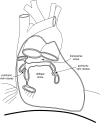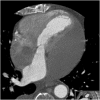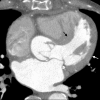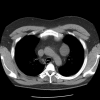Imaging the pericardium: appearances on ECG-gated 64-detector row cardiac computed tomography
- PMID: 20197434
- PMCID: PMC3473560
- DOI: 10.1259/bjr/55699491
Imaging the pericardium: appearances on ECG-gated 64-detector row cardiac computed tomography
Abstract
Multidetector row computed tomography (MDCT) with its high spatial and temporal resolution has now become an established and complementary method for cardiac imaging. It can now be used reliably to exclude significant coronary artery disease and delineate complex coronary artery anomalies, and has become a valuable problem-solving tool. Our experience with MDCT imaging suggests that it is clinically useful for imaging the pericardium. It is important to be aware of the normal anatomy of the pericardium and not mistake normal variations for pathology. The pericardial recesses are visible in up to 44% of non-electrocardiogram (ECG)-gated MDCT images. Abnormalities of the pericardium can now be identified with increasing certainty on 64-detector row CT; they may be the key to diagnosis and therefore must not be overlooked. This educational review of the pericardium will cover different imaging techniques, with a significant emphasis on MDCT. We have a large research and clinical experience of ECG-gated cardiac CT and will demonstrate examples of pericardial recesses, their variations and a wide variety of pericardial abnormalities and systemic conditions affecting the pericardium. We give a brief relevant background of the conditions and reinforce the key imaging features. We aim to provide a pictorial demonstration of the wide variety of abnormalities of the pericardium and the pitfalls in the diagnosis of pericardial disease.
Figures














References
-
- Kini S, Bis KG, Weaver L. Normal and variant coronary arterial and venous anatomy on high-resolution CT angiography. AJR Am J 2007;188:1665–74 - PubMed
-
- Cury RC, Nieman K, Shapiro MD, Nasir K, Cury RC, Brady TJ. Comprehensive cardiac CT study: evaluation of coronary arteries, left ventricular function and myocardial perfusion — is it possible? J Nuc Cardiol 2007;14:229–43 - PubMed
-
- Broderick LS, Brooks GN, Kuhlman JE. Anatomic pitfalls of the heart and pericardium. Radiographics 2005;25:441–53 - PubMed
-
- Bull RK, Edwards PD, Dixon AK. CT dimensions of the normal pericardium. Br J Radiol 1998;71:923–5 - PubMed
-
- Truong MT, Erasmus JJ, Gladish GW, Sabloff BS, Marom EM, Madewell JE, et al. Anatomy of pericardial recesses on multidetector CT: implications for oncologic imaging. AJR 2003;181:1109–13 - PubMed
Publication types
MeSH terms
LinkOut - more resources
Full Text Sources
Other Literature Sources
Medical

